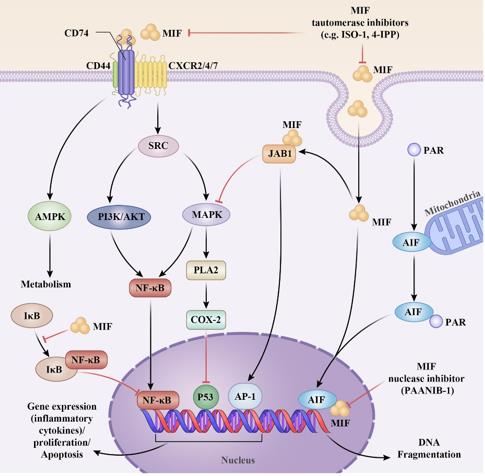What is MIF Protein
MIF, or Macrophage Migration Inhibitory Factor, stands as a pivotal player in the intricate world of proteins. Also known by its aliases—glycosylation-inhibiting factor (GIF) and phenylpyruvate tautomerase—the MIF protein falls under the superfamily of isomerases. Its structure, resembling a traditional cytokine, comprises a trimeric form with each subunit contributing to its biological activities.
In recent research, groundbreaking discoveries have unraveled new dimensions of the MIF protein. Its role in immune responses, inflammation, and various cellular processes has become increasingly evident. Scientists are delving deeper into the molecular intricacies of MIF, unveiling its multifaceted functions and potential therapeutic applications.
MIF Biological Functions and Molecular Mechanisms
The biological functions of MIF are extensive, reflecting its versatile nature. One of its primary roles is to counteract the inhibition of macrophage migration—a vital aspect of immune response. MIF also plays a crucial part in the regulation of inflammation by promoting the production of pro-inflammatory cytokines, such as tumor necrosis factor-alpha (TNF-α) and interleukin-1beta (IL-1β).
MIF's molecular mechanisms involve interactions with various cellular receptors, including CD74, CXCR2, and CD44. Through these interactions, MIF influences signaling pathways that impact cell survival, proliferation, and immune responses. Additionally, MIF exhibits enzymatic activity, acting as a tautomerase, which contributes to its functional diversity.
MIF Related Signaling Pathway
MIF's influence extends to intricate signal pathways, orchestrating cellular responses. Its interactions with CD74 initiate downstream signaling cascades, impacting immune cell recruitment and activation. Moreover, MIF's engagement with CXCR2 and CD44 contributes to its pro-inflammatory effects, amplifying the signaling network.
In cancer, MIF's involvement in the PI3K/Akt and MAPK pathways promotes cell survival and proliferation. Understanding these signal pathways provides valuable insights into potential therapeutic strategies aimed at modulating MIF-related signaling to counteract disease progression.

Figure 1. MIF signaling pathway. (Zhang Y, et al., 2023)
MIF Related Diseases
The dark side of MIF emerges when its finely tuned functions go awry, leading to associations with several diseases. Rheumatoid arthritis, a chronic inflammatory disorder, showcases elevated MIF levels, contributing to the perpetuation of inflammation and joint damage. In cancer, MIF's involvement has been noted in promoting tumor growth and angiogenesis, marking it as a potential target for anticancer therapies.
Neurological disorders, such as Alzheimer's disease, also exhibit an interplay with MIF. Elevated MIF levels in the brain contribute to neuroinflammation and neuronal damage. Unraveling the complexities of MIF's role in these diseases provides avenues for targeted therapeutic interventions.
MIF's Applications in Biomedicine
The diverse functionalities of MIF make it a promising candidate for various biomedical applications. In diagnostic development, MIF serves as a potential biomarker for diseases characterized by inflammation, enabling early detection and monitoring of pathological conditions.
Vaccine development leverages MIF's immunomodulatory properties to enhance immune responses. Targeting MIF in vaccine formulations holds promise for generating robust and effective immune reactions against infectious agents and cancers.
Therapeutically, MIF inhibitors are under investigation for their potential in treating inflammatory diseases and cancer. Small molecules targeting MIF could provide a novel approach to intervene in pathological processes driven by aberrant MIF activity.
Recommended Products
| Cat.No. | Product Name | Species | Source (Host) | Tag |
|---|---|---|---|---|
| MIF-09H | Active Recombinant Human MIF | Human | E.coll | N/A |
| MIF-650H | Active Recombinant Human MIF, His-tagged | Human | E.coli | His |
| MIF-30234TH | Recombinant Human MIF, His-tagged | Human | E.coli | His |
| MIF-23H | Recombinant Human MIF protein, His-tagged | Human | E.coli | His |
| MIF-277H | Recombinant Human MIF | Human | Mammalian Cell | His |
| MIF-4742H | Recombinant Human MIF protein | Human | E.coli | N/A |
| MIF-81H | Recombinant Human MIF, His-tagged | Human | E.coli | His |
| MIF-24H | Recombinant Human MIF, His-tagged N-Terminus | Human | E.coli | His |
| MIF-3816H | Recombinant Human MIF protein, His-tagged | Human | HEK293 | His |
| Mif-4001M | Recombinant Mouse Mif protein, His-tagged | Mouse | HEK293 | His |
Reference
- Zhang Y, et al. Macrophage migration inhibitory factor (MIF) in CNS diseases: Functional regulation and potential therapeutic indication. Fundamental Research. 2023.

